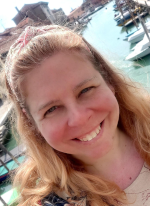Women in Engineering Day 2022 - Meet Erin
To mark International Women in Engineering Day 2022, we had a chat with Erin Dooley, a Research Associate and Lecturer in Digital Heath at the University of Bristol.

Hi, I’m Erin! I am a scientist, artist, and teacher with a passion for all things STEAM (science, technology, engineering, art, and maths). I am a keen proponent of interdisciplinary thinking and working with a focus on research in responsible innovation and disability. I have a passion for sharing and communicating my scientific interests through public engagement and life-long learning.
So Erin, what first got you interested in Engineering?
What really got me into engineering was the natural world. A seashell and the elegant Fibonacci sequence swirl contained inside, the shape of a seagull’s wing or a dolphin surfing the waves, how did all these amazing creatures evolve? Nature may not be an obvious starting point for understanding engineering, but if you look closely, you will find that nature is the ultimate engineer.
If you could go back to your school days, what would you say to your younger self about your career choices?
I would say to myself that no education or curiosity is wasted; you may not know how or when you are going to use a piece of knowledge or a particular skill, but as life presents itself, you will find a use for it. Stay open and stay curious and have the confidence to stand by your own ideas, path, and vision. If something does not already exist that fits your unique skills and way of thinking/working, give it time, or forge ahead and create it yourself.
What was the route you took into Digital Health?
In 2013 I found an unusual spot on my wrist which progressively evolved, it was melanoma skin cancer. I went to the GP and a photo was sent to the dermatologist, but I was initially mis-diagnosed as the photo looked normal. This got me thinking about Digital Health and all the potentials and limitations of a remote diagnosis. What makes a beneficial and functional Digital Health system? What are the dangers and opportunities? How can we combine the art and wisdom of face-to-face medicine with a computer or a machine? These questions led me to explore Digital Health and now it is my career.
How would you describe your experience of being a woman in Engineering?
Like many girls and women, as a younger student, I was encouraged to do well in science and maths but in progressing to secondary school, I noted that I was one of the few girls engaged with science outside of the classroom. Women in engineering are often referred to as the ‘leaky pipe’, as women, girls and non-binary individuals progress through scientific academic study, but then ultimately disengage from the technical research and employment opportunities.
As I progressed through a STEM career, I have been equally delighted and amazed that things are improving and that there are more women and non-binary people working in engineering. I feel that this reflects a real value change in the discipline and that engineering has become a more inclusive space.
What advice would give to a female looking to get into Digital Health?
Go for it! Take the time to research the field, audit your current skills and experience, recognise where you may need training and up-skilling. Digital Health is a novel, growing and dynamic field which includes medicine, law, ethics, engineering, design and social science; there is a place at the table for everyone who is passionate about delivering improved healthcare through team-working and growth mindset.
What’s next for you?
I would like to continue an academic pathway in Digital Health research and course/content delivery but would also like to combine this with more science communication, outreach and community work. I would like to explore Digital Health at the government policy level and how robust legislation can better help the delivery of holistic healthcare to those living with disability and their careers.
